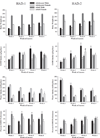Daily patterns of ethanol drinking in adolescent and adult, male and female, high alcohol drinking (HAD) replicate lines of rats
- PMID: 22750062
- PMCID: PMC4577280
- DOI: 10.1016/j.pbb.2012.04.017
Daily patterns of ethanol drinking in adolescent and adult, male and female, high alcohol drinking (HAD) replicate lines of rats
Abstract
The rationale for our study was to determine the pattern of ethanol drinking by the high alcohol-drinking (HAD) replicate lines of rats during adolescence and adulthood in both male and female rats. Rats were given 30 days of 24 h free-choice access to ethanol (15%, v/v) and water, with ad lib access to food, starting at the beginning of adolescence (PND 30) or adulthood (PND 90). Water and alcohol drinking patterns were monitored 22 h/day with a "lickometer" set-up. The results indicated that adolescent HAD-1 and HAD-2 males consumed the greatest levels of ethanol and had the most well defined ethanol licking binges among the age and sex groups with increasing levels of ethanol consumption throughout adolescence. In addition, following the first week of adolescence, male and female HAD-1 and HAD-2 rats differed in both ethanol consumption levels and ethanol licking behavior. Adult HAD-1 male and female rats did not differ from one another and their ethanol intake or licking behaviors did not change significantly over weeks. Adult HAD-2 male rats maintained a relatively constant level of ethanol consumption across weeks, whereas adult HAD-2 female rats increased ethanol consumption levels over weeks, peaking during the third week when they consumed more than their adult male counterparts. The results indicate that the HAD rat lines could be used as an effective animal model to examine the development of ethanol consumption and binge drinking in adolescent male and female rats providing information on the long-range consequences of adolescent alcohol drinking.
Published by Elsevier Inc.
Conflict of interest statement
None of the authors have real or perceived conflicts of interest associated with this work.
Figures





Similar articles
-
Daily patterns of ethanol drinking in peri-adolescent and adult alcohol-preferring (P) rats.Pharmacol Biochem Behav. 2006 Jan;83(1):35-46. doi: 10.1016/j.pbb.2005.12.004. Epub 2006 Jan 26. Pharmacol Biochem Behav. 2006. PMID: 16442608
-
Intermittent access to beer promotes binge-like drinking in adolescent but not adult Wistar rats.Alcohol. 2009 Jun;43(4):305-14. doi: 10.1016/j.alcohol.2009.02.005. Epub 2009 Apr 17. Alcohol. 2009. PMID: 19375883
-
Intermittent voluntary ethanol consumption combined with ethanol vapor exposure during adolescence increases drinking and alters other behaviors in adulthood in female and male rats.Alcohol. 2018 Dec;73:57-66. doi: 10.1016/j.alcohol.2018.04.003. Epub 2018 Apr 18. Alcohol. 2018. PMID: 30293056 Free PMC article.
-
Scheduled access alcohol drinking by alcohol-preferring (P) and high-alcohol-drinking (HAD) rats: modeling adolescent and adult binge-like drinking.Alcohol. 2014 May;48(3):225-34. doi: 10.1016/j.alcohol.2013.10.004. Epub 2013 Oct 31. Alcohol. 2014. PMID: 24290311 Free PMC article. Review.
-
The alcohol-preferring (P) and high-alcohol-drinking (HAD) rats--animal models of alcoholism.Alcohol. 2014 May;48(3):209-15. doi: 10.1016/j.alcohol.2013.09.044. Epub 2013 Oct 30. Alcohol. 2014. PMID: 24268381 Free PMC article. Review.
Cited by
-
Intranasal mesenchymal stem cell secretome administration markedly inhibits alcohol and nicotine self-administration and blocks relapse-intake: mechanism and translational options.Stem Cell Res Ther. 2019 Jul 8;10(1):205. doi: 10.1186/s13287-019-1304-z. Stem Cell Res Ther. 2019. PMID: 31286996 Free PMC article.
-
Sex differences in the glutamate system: Implications for addiction.Neurosci Biobehav Rev. 2020 Jun;113:157-168. doi: 10.1016/j.neubiorev.2020.03.010. Epub 2020 Mar 12. Neurosci Biobehav Rev. 2020. PMID: 32173404 Free PMC article. Review.
-
Involvement of Purinergic P2X4 Receptors in Alcohol Intake of High-Alcohol-Drinking (HAD) Rats.Alcohol Clin Exp Res. 2015 Oct;39(10):2022-31. doi: 10.1111/acer.12836. Epub 2015 Sep 3. Alcohol Clin Exp Res. 2015. PMID: 26334550 Free PMC article.
-
Evaluating signs of hippocampal neurotoxicity induced by a revisited paradigm of voluntary ethanol consumption in adult male and female Sprague-Dawley rats.Pharmacol Rep. 2023 Apr;75(2):320-330. doi: 10.1007/s43440-023-00464-6. Epub 2023 Feb 20. Pharmacol Rep. 2023. PMID: 36807777 Free PMC article.
-
Differences between male and female rats in alcohol drinking, negative affects and neuronal activity after acute and prolonged abstinence.Int J Physiol Pathophysiol Pharmacol. 2019 Aug 25;11(4):163-176. eCollection 2019. Int J Physiol Pathophysiol Pharmacol. 2019. PMID: 31523363 Free PMC article.
References
-
- Adams N. Sex differences and the effects of tail pinch on ethanol drinking in Maudsley rats. Alcohol. 1995;12:463–468. - PubMed
-
- Bell RL, Rodd-Henricks ZA, Kuc KA, Lumeng L, Li TK, Murphy JM, et al. Effects of concurrent access to a single concentration or multiple concentrations of ethanol on the intake of ethanol by male and female periadolescent alcohol-preferring (P) rats. Alcohol. 2003;29:137–148. - PubMed
-
- Bell RL, Rodd ZA, Hsu CC, Lumeng L, Li TK, Murphy JM, et al. Effects of concurrent access to a single concentration or multiple concentrations of ethanol on ethanol intake by periadolescent high-alcohol-drinking rats. Alcohol. 2004;33:107–185. - PubMed
-
- Bell RL, Rodd ZA, Sable HJK, Schultz JA, Hsu CC, Lumeng L, et al. Daily patterns of ethanol drinking in periadolescent and adult alcohol preferring (P) rats. Pharmacol Biochem Behav. 2006;83:35–46. - PubMed
Publication types
MeSH terms
Grants and funding
LinkOut - more resources
Full Text Sources
Medical

